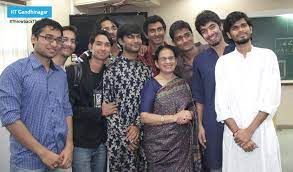SOURCE: NEWS 18
Hamida Banu Chopra teaches Urdu language and literature at the University of California, Berkeley. A renowned reciter of Urdu poetry, she received her MA in Philosophy from Rajasthan University and an advanced degree in Urdu from Aligarh University.
SOURCE: CENTRE FOR TRANSLATION
Urdu was born in India and was formerly called as Hindvi which means born in Hindustan (India), said Prof Hamida Banu Chopra during the sixth edition of the Introduction to Indian Knowledge Systems (IKS), an elective course at the Indian Institute of Technology (IIT) Gandhinagar. Professor Chopra is a visiting faculty at the IIT.
IIT Gandhinagar hosted three lectures by Prof Hamida Banu Chopra, an eminent expert of Urdu language and literature, on April 7, 8, and 12. The three lectures, taked about ‘The Origin and Evolution of Urdu Language’, ‘Ghazal, Nazm and Rubai: The Beautiful Development of Urdu Literature’, and recitation of ‘Chakbast’s Urdu Ramayana’.
Tracing the origin, history, and evolution of the Urdu language, Prof Chopra said, “The 15th century Mughal Empire had Turkish, Baluchistani, Samarkandi, and Hindustani soldiers in its army situated at and near Delhi. Their communication gave rise to a language, which was also influenced by other languages spoken in the areas close to Delhi. With time, this language was called Hindvi, and it also became popular among Sufi saints and the masses. Hindvi is the first name of the Urdu language, meaning born in India. The time of Bahadur Shah Zafar is called the golden era of the Urdu language.”
In her second lecture, she underlined the significant contributions of some Urdu poets and writers to society in the form of critical life lessons given in through their poetry. “Hindi and Urdu are different languages, but each utilizes several words from another. Moreover, their grammar is the same, making them two sisters”, she said.
In the third lecture, Prof Chopra introduced the Urdu poet Brij Narayan Chakbast (1882-1926). She recited and explained some parts of his nazm - “Ramayan ka Ek Scene.”

